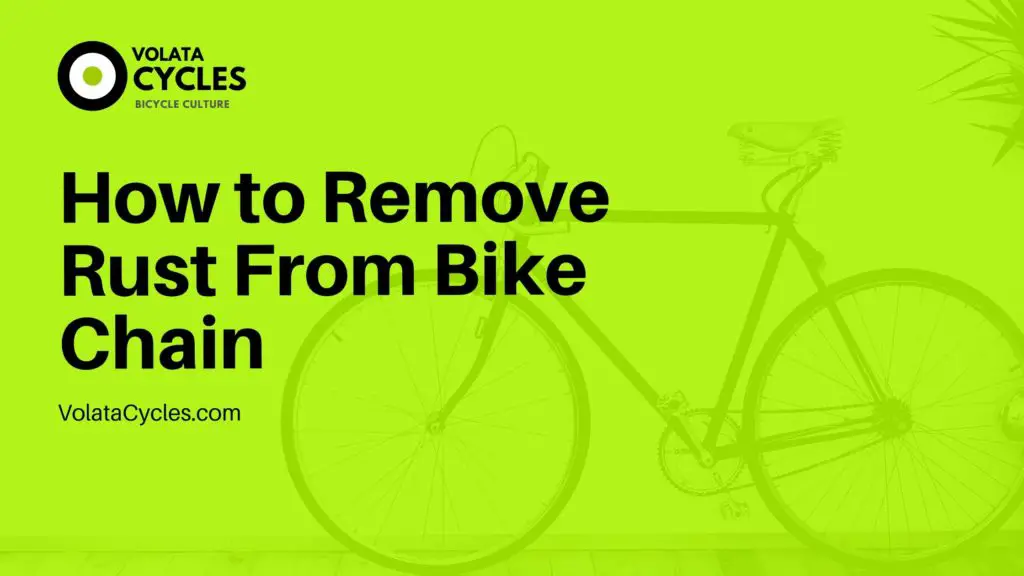It hardly matters whether you’ve just gotten into biking or are an experienced biker, there’ll come a point in your biking life when your bike chain starts to rust. Bike chains and rust are simply two substances that are designed to attract each other no matter how careful you try to be.
Removing rust from a bike chain can be quite problematic, especially if the rust had already been accumulating for a while. Indeed, depending on how badly your bike chain is rusted, it might even cost more to remove the rust than to replace the chain entirely.
However, if your bike chain is still pliable and looks as though it needs just a bit of rust removal, then follow the steps below. We’ll share with you different, tried-and-tested methods that will remove rust from your bike chain in a jiffy.

It will definitely be helpful for the avid biker to learn how to remove rust from his bike chain, but we believe it’s even more helpful in the long run if they learned how to maintain their bike so that the tedious process of removing rust from the bike chain needn’t happen as often.
How to Remove Rust From Bike Chain?
Step 1: Inspect the Chain and Determine Course of Action
First, inspect the bike chain to determine how rusty it is. If the chain is in the initial stages of rusting, then you might be able to clean the chain where it is without having to remove it from the bike. But if the chain is substantially rusted, then you’ll have to detach the chain from the bike so you can clean it more thoroughly.
If you find that the rusting on your chain is severe, then the best thing to do might be to simply replace the chain entirely. Don’t fret, a new, quality chain shouldn’t cost that much. You can get a good one for around $30 or less. But if your bike is on the expensive side, that could jump to as high as $100.
Really, your mileage will vary and will depend on both your bike and your preference. So it is ultimately up to you to figure out whether you’re better off purchasing an entirely new chain or going through the steps mentioned here to remove the rust from your chain.
Step 2: Use a Degreaser
Assuming you’ve decided against purchasing a new chain, the next step in removing the rust would be to choose a degreaser. This will allow you to remove all the grease and gunk that inconveniently rests on top of the rust. In other words, without a degreaser, you might not be able to reach a lot of areas of the chain that have rusted through.
There are many degreasers available on the market, with some working more effectively than others. From our experience, degreasers like WD-40 and Green Smoove Prep work just fine. But if you have a particular one in mind that works best for you, you can try that, too. We recommend that you read the brand’s online reviews, however, to ensure that you’re getting a quality product and one that won’t damage the chain or the surface of your bike.
Depending on how greasy your chain is, you can either soak a rag in the degreaser and run it through your chain or pour the degreaser in a plastic container, submerge the chain in it, and leave it for about 20 minutes. Either way, you need to wear gloves because exposure to degreasers can damage your skin.
Step 3: Removing the Rust
You’ll need the use of steel wool and some rust remover for this step. It’s up to you what kind of rust remover to use. You can definitely purchase a product specifically made to remove rust from a store, but from our experience, lime juice or white vinegar will do.
Basically, all you need to do is pour the rust remover onto the steel wool and wipe the rust away from the chain. Make sure that you are able to reach tight crevices. Also, keep your gloves on as this step can be particularly rough on the skin. When the steel wool gets filled with rust, which it will after a while, simply discard it, get another piece and repeat the whole process.
Step 4: Rinse the Chain
Once you’re certain you’ve successfully wiped all the rust away from the chain, the next step is to clean the chain thoroughly to make sure no steel wool or rust remover is left, as this could lead to a build-up of more rust in the future. Water, soap and a toothbrush are all that you’ll need for this.
Step 5: Lubricating Your Chain
Yes, it is exactly as it sounds. Once you’ve cleaned your chain from all the excess rust remover, the next step is to lubricate your chain. After all, if you don’t lubricate your chain, it will simply rust again, making you have to go through the whole process once more.
What lubrication to use on your chain is really up to you. There are many available in the market that are good, and we can recommend WD-40 Chain Lube since that’s what we often use, but, really, any lube with good online reviews will do.
Estimated Cost: 30 USD
The Bottomline
There really isn’t anything one can do to completely avoid a rusting chain. It will happen to everyone, no matter how careful they are. There are many products in the market that will claim to be able to remove rust fast and easily, but nothing beats a good degreasing and wash down with simple white vinegar or lime juice.
Remember, lubricating your chain regularly—and especially after having removed the rust—will help make it more impervious to rust build-up, so don’t forget to do that. Also, don’t forget that sometimes it is simply better—and more cost-efficient—to just replace the chain entirely when the rusting is severe.
